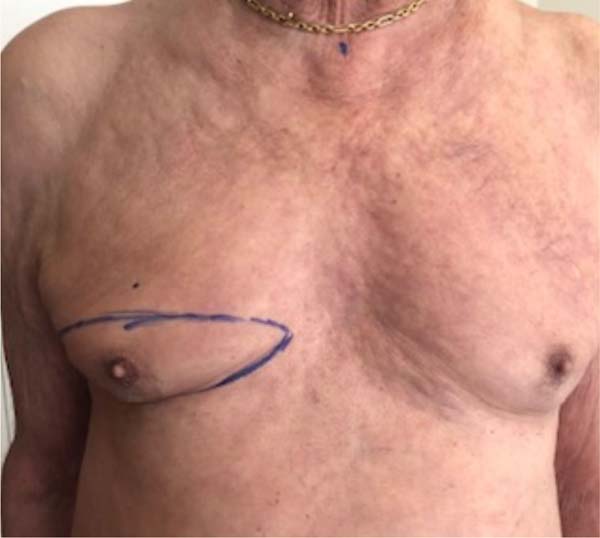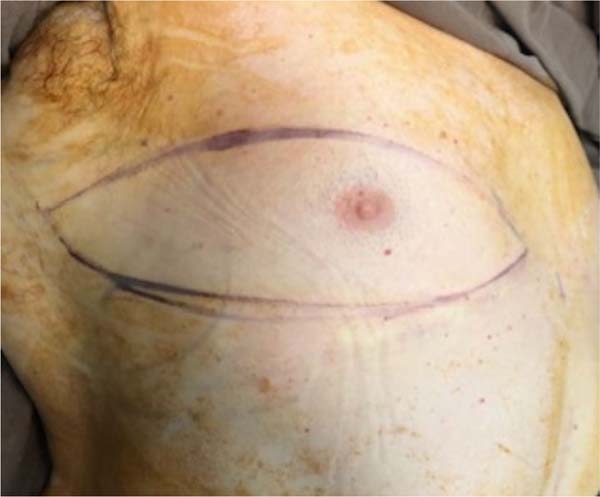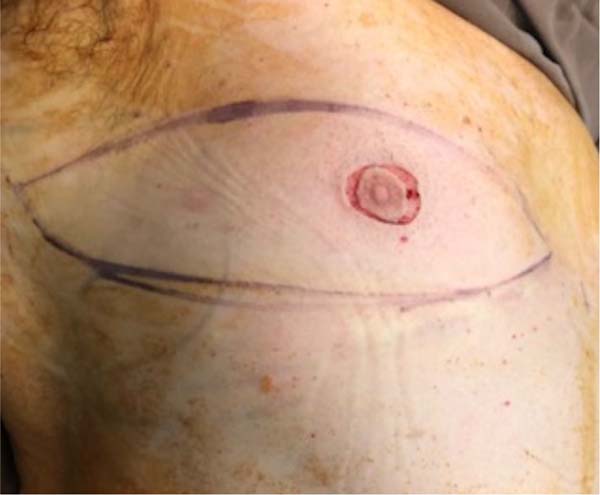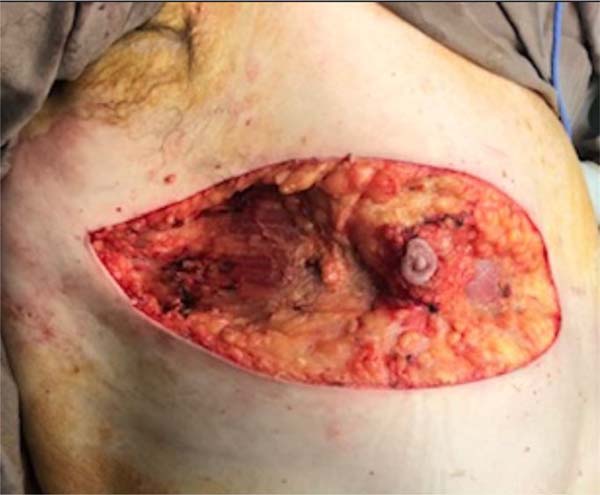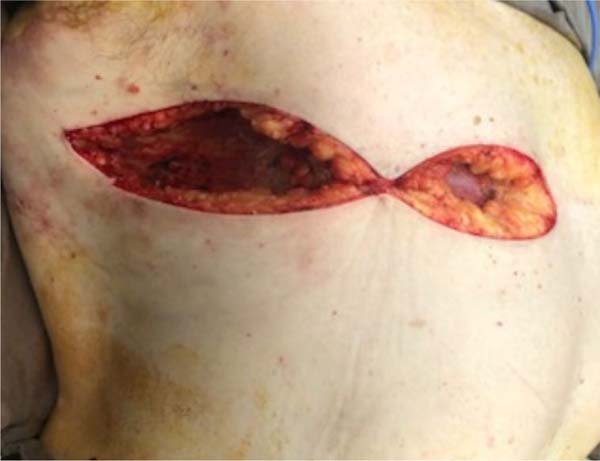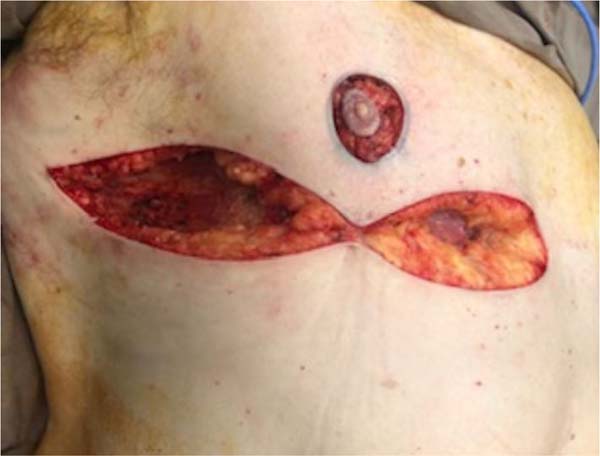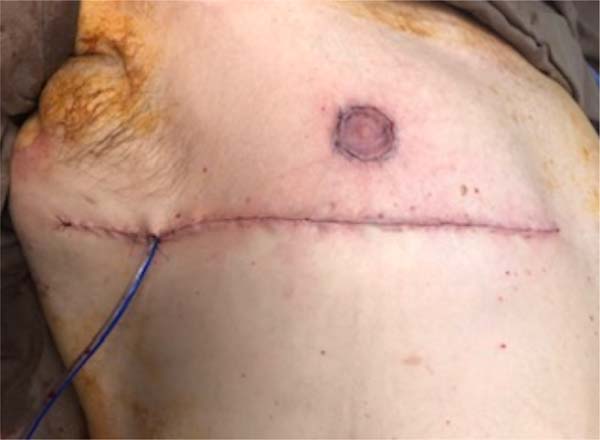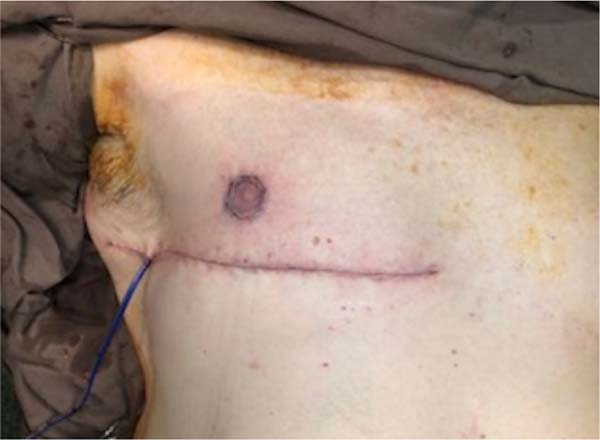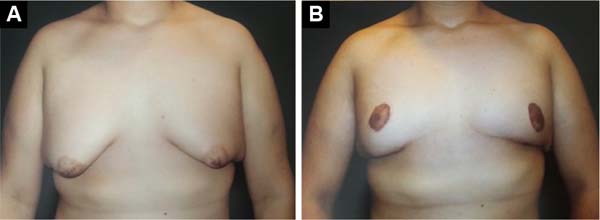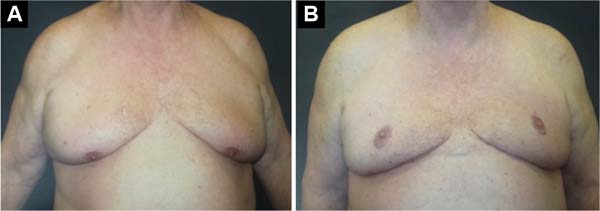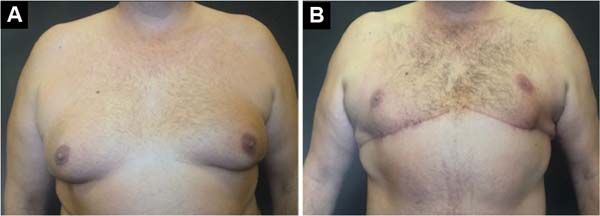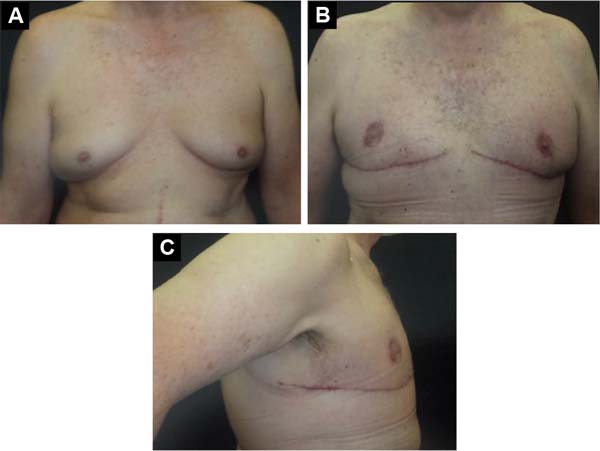INTRODUCTION
Gynecomastia is defined as pathological breast enlargement in men, which may be
associated with the presence of fatty tissue (lipomastia) and/or excess
skin1-5. The first surgical description was made by
Paulo de Égina (625 AD), and the most common surgical technique is subcutaneous
mastectomy via the areolar route, with or without liposuction1,5-7.
The classification used to grade gynecomastia was proposed in 1973 by
Simon1:
Grade I - Small, without excess skin;
Grade II a - Moderate, without excess skin;
Grade II b - Moderate, with excess skin;
Grade III - Large, with excess skin.
The demand for surgery to correct gynecomastia has increased due to many patients
undergoing bariatric treatments1. Most of these patients are grade III of the classification
above and require extensive removal of excess skin, and fatty tissue,
repositioning of the nipple-areolar complex (NAC), and adjustment of the areola
volume5.
The techniques used for advanced cases of gynecomastia were, in most cases,
adapted from reduction mammaplasty techniques in women, which can determine
stigmatization of patients with large inverted “T” scars, for example5,8.
OBJECTIVE
This study aims to describe the correction technique for grade III gynecomastia
using a horizontal scar without a vertical scar with NAC repositioning and to
evaluate its applicability, morbidity, and surgical results.
METHOD
Prospective study of 27 male patients diagnosed with Simon grade III
gynecomastia, operated in a private clinic in Curitiba-PR between January 2013
and August 2020, using the horizontal scar technique with NAC repositioning
(transposition) and without vertical scar. All patients were seen up to the
sixth postoperative month (PO).
Operative technique
Patient in orthostatic position; marking of point “A” (Pitanguy’s point) 16cm
from the sternal notch; submammary fold marking (SFM); bidigital palpation
of excess skin (redundant skin) to be resected in the upper portion of the
breast in the form of a transverse spindle (Figures 1 and 2) that
extends from the lateral edge of the sternum to the anterior axillary line,
or posterior, according to the amount of skin to be removed.
Figure 1 - Marking of the “A” point 16cm from the sternal notch, marking
the submammary fold and the spindle (through a digital maneuver)
of the skin to be resected.
Figure 1 - Marking of the “A” point 16cm from the sternal notch, marking
the submammary fold and the spindle (through a digital maneuver)
of the skin to be resected.
Figure 2 - Marking the skin spindle to be removed.
Figure 2 - Marking the skin spindle to be removed.
The patient is in dorsal decubitus, 2g of intravenous cefazolin under general
and local anesthesia in a 1/230,000UI saline solution, and epinephrine + 20
ml of ropivacaine. Infiltration of the entire previously marked area. Use of
a small areolotome, removal of excess areolar skin (Figure 3), maintenance of the NAC in the posterior
pedicle based on the fourth intercostal perforating branch (Figure 4), and removal of all excess
glandular and fatty tissue in a previously marked area (transverse spindle).
The size of the flap is proportional to the NAC volume, 3 x 3cm at the base
and length, and can reach up to 9cm. Drainage with a 4.8 suction, suturing
the edges in 3 layers (Figure 4); NAC
positioning at point “A” (Figures 5,
6, 7, 8, and 9).
Figure 3 - Skin and subcutaneous tissue incision in the nipple-areolar
complex.
Figure 3 - Skin and subcutaneous tissue incision in the nipple-areolar
complex.
Figure 4 - Removal of excess tissue (fat and gland) and maintenance of
the nipple-areolar complex in the posterior pedicle of the
fourth intercostal branch.
Figure 4 - Removal of excess tissue (fat and gland) and maintenance of
the nipple-areolar complex in the posterior pedicle of the
fourth intercostal branch.
Figure 5 - Beginning of the suture between the upper and lower
edges.
Figure 5 - Beginning of the suture between the upper and lower
edges.
Figure 6 - Place where the nipple-areolar complex will be positioned at
point “A.”
Figure 6 - Place where the nipple-areolar complex will be positioned at
point “A.”
Figure 7 - Transposition of the nipple-areolar complex.
Figure 7 - Transposition of the nipple-areolar complex.
Figure 8 - Anterolateral view - immediate postoperative period.
Figure 8 - Anterolateral view - immediate postoperative period.
Figure 9 - Anterior view - immediate postoperative period.
Figure 9 - Anterior view - immediate postoperative period.
RESULTS
Twenty-seven patients underwent surgery over 7.5 years, all formerly obese
previously submitted to weight loss treatment. Age ranged from 17 to 74 years
old, mean age of 52. The weight of the removed pieces ranged from 175 to 758
grams, an average of 376 grams (Figures 10, 11, 12, 13 and 14).
Figura 10 - A: Frontal view, 17-year-old patient preoperatively;
B: Frontal view, 17-year-old patient in the eighth
postoperative month.
Figura 10 - A: Frontal view, 17-year-old patient preoperatively;
B: Frontal view, 17-year-old patient in the eighth
postoperative month.
Figura 11 - A: Frontal view, 54-year-old patient preoperatively;
B: Frontal view, 54-year-old patient in the sixth
postoperative month.
Figura 11 - A: Frontal view, 54-year-old patient preoperatively;
B: Frontal view, 54-year-old patient in the sixth
postoperative month.
Figura 12 - A: Frontal view, 74-year-old patient preoperatively;
B: Frontal view, 74-year-old patient in the eighth
postoperative month.
Figura 12 - A: Frontal view, 74-year-old patient preoperatively;
B: Frontal view, 74-year-old patient in the eighth
postoperative month.
Figura 13 - A: Frontal view, preoperative 43-year-old patient;
B: Frontal view, 43-year-old patient in the fourth
postoperative month.
Figura 13 - A: Frontal view, preoperative 43-year-old patient;
B: Frontal view, 43-year-old patient in the fourth
postoperative month.
Figura 14 - A: Frontal view, 57-year-old patient preoperatively;
B: Frontal view, 57-year-old patient in the third
postoperative month; C: Right lateral view, 57-year-old
patient in the 3rd month PO with scar extending to the posterior
axillary line.
Figura 14 - A: Frontal view, 57-year-old patient preoperatively;
B: Frontal view, 57-year-old patient in the third
postoperative month; C: Right lateral view, 57-year-old
patient in the 3rd month PO with scar extending to the posterior
axillary line.
The complications were:
- 1 case of late hematoma = 3.7%
- 1 case of seroma = 3.7%
- 2 cases of hypertrophic scarring = 7.4%
DISCUSSION
With the increasing incidence of obesity in Western societies and the development
of bariatric surgery, grade III gynecomastia and pseudogynecomastia have also
increased. Overweight patients should preferentially be treated with techniques
that allow a large amount of tissue to be removed and allow for the
repositioning of the NAC8. The
first report of the reduction mammoplasty technique without a vertical scar is
credited to Passot in 1920. The excess tissue was removed in a wedge only from
the pole lower breast9. This
technique was used in cases with minimal hypertrophy and moderate ptosis.
The most traditionally proposed techniques would be mastectomy with NAC graft or
areolar pedicle flap techniques. Among them, one can choose the superior
pedicle, inferior pedicle, or posteroinferior pedicle. NAC grafting is a simple
technique, but it has some disadvantages, such as the absence of NAC
sensitivity, the chance of non-graft integrity with the risk of pathological
scars and even necrosis, and especially the need for dressings and special care
in the graft area for at least 10 to 14 PO days. The techniques that use the
pedicle have the great advantage of maintaining the vascular nerve bundle; that
is, there is the preservation of the tactile sensitivity of the NAC8, repeating that this does not
occur in cases of NAC graft.
The Lalonde female breast reduction technique can be applied to treating male
breast enlargement in patients at high risk of scarring complications. It offers
an alternative to the more widely used concentric skin reduction
techniques10. Kazzazi
& Malata10 describe this
as the first report in the literature on applying the Lalonde surgical technique
“without vertical scar” for treating gynecomastia in patients with darkly
pigmented skin.
The resulting horizontal scar, used in this study, allows a large resection of
redundant and flaccid tissues, as it can extend to the posterior axillary line
or the back in cases where it is associated with dorsoplasty, restoring the
masculinity of the chest of men with positioning end of the scar in the SFM,
in
the transition between the thorax and the abdomen, which makes it quite
aesthetically acceptable, and also, in a way, disguised next to the SFM.
The study by Resende5 and also
by Rocha et al.1 ended with a
horizontal scar in the middle of the aesthetic unit of the thorax, a scar that
is quite apparent, unlike the one shown in this study. As a positive factor,
this study also has the absence of a vertical scar (adapted from traditional
reduction mammoplasty techniques) that stigmatizes patients with scars similar
to those of women. In our midst, Mansur et al.11 described the extension of the scar to the
back, treating the arm, breast, and back concomitantly. As in this study,
vertical scars on the breasts are avoided.
The upper part of the thorax, the area close to point “A,” where the NAC will be
transposed, must be considerably thinned by removing the fatty tissue in the
lamellar layer, leaving the flap very thin with only the areolar layer of fat,
thus avoiding form, residual fat in this region.
The lipectomy performed here is performed with electrocautery and scissors. We
did not use liposuction as described by Thiénot et al.8, who reported a volume
aspirated between 450 and 800ml of fat from each patient. The weight of tissue
removed in this study was similar to that of the publication by Thiénot et al.,
although, in the case of the French study, their flap is larger than the one
described here. The inferoposterior flap is larger than the posterior areola
flap, based on the “plug flap” described by Daher12 and Carramaschi et al.13 for breast reconstruction
based on intercostal perforating vessels. Therefore, since the French flap was
larger, one could imagine less tissue removal in the European study.
Concerning complications, this sample showed lower values than those reported in
the literature. One case of hematoma (3.7%) had a lower value than that of Varma
& Henderson14, which was
6%, Maetz et al.15, 8%, and
Colombo-Benkmann et al.16,
11%. The first two studies cited had a sample of 17 and 12 patients14,15, smaller than the one presented here, of 27 patients.
On the other hand, Colombo-Benkmann et al.16 conducted a very robust study with 100 patients, a
large sample.
The study by Thiénot et al.8 did
not have any case of a hematoma; however, it had a casuistry 3 times smaller
than the one presented here (27 cases). The authors justify the absence of
hematoma by using extensive liposuction before tissue resection, which would
preserve the lymphatics and reduce the chance of hematoma and seroma. In this
study, 1 case of seroma (3.7%) and 2 cases of hypertrophic scars were observed
in the sixth month, which were treated with topical corticosteroid tape 12 hours
a day for 4 months, with resolution of the problem.
As previously mentioned, the posterior perforating flap of the fourth intercostal
vessel was based on the island flap initially described for breast
reconstruction12,13. It is a fixed flap on the
chest wall, but with mobility that can easily reach the “A” point. In cases of
superolateral quadrantectomies, Daher12 and Carramaschi et al.13 demonstrated its safety and versatility.
Comparing its volume with the posteroinferior flap, it is much smaller and does
not present the same risks of postoperative ptosis, as described by Thiénot et
al.8, since its width
is 6 cm, the thickness of the base is 8-10 cm and the thickness retroareolar
is
2 to 3 cm.
The flap volume described here is 3 x 3 cm at the base and may extend up to 9 cm
in length. It is worth remembering that the inferior pedicle, bordered or not,
described by Liacyr Ribeiro in 197315, is similar to the Thiénot flap and had its
effectiveness improved with the use of the pectoralis major muscle strap,
described by Milton Daniel in 199315, avoiding thus the ptosis of the flap at PO15. That is, this corroborates
the concern of Thiénot et al.8
with the possibility of flap ptosis due to its size and weight.
The main limitations of this study are the absence of NAC sensitivity tests,
which would demonstrate maintenance of sensory innervation, and preoperative
arteriography or intraoperative arterial Doppler that showed the perforating
branches of the fourth intercostal artery.
CONCLUSION
Surgical treatment of grade III gynecomastia using the horizontal scar technique,
without a vertical scar and with repositioning of the NAC, proved effective,
as
it allows large and wide tissue resection, with low morbidity and good aesthetic
results.
1. Clínica Privada, Curitiba, PR,
Brazil
2. Hospital Universitário Cajuru, Pontifícia
Universidade Católica do Paraná, Curitiba, PR, Brazil
3. Pontifícia Universidade Católica do Paraná,
Escola de Medicina, Curitiba, PR, Brazil
Corresponding author: Lincoln Graça Neto Rua
Alferes Angelo Sampaio, 2029, Curitiba, PR, Brazil, Zip Code: 80420-160, E-mail:
lgracaneto@hotmail.com



